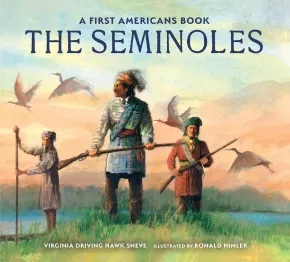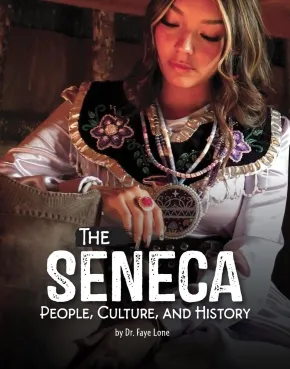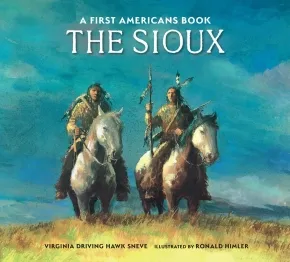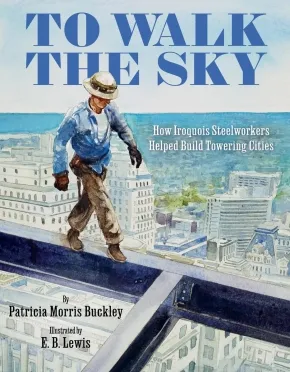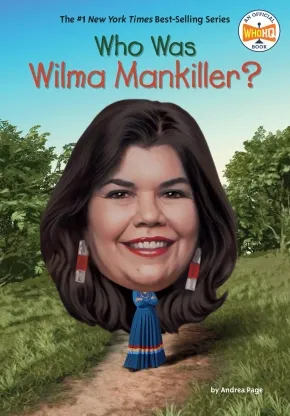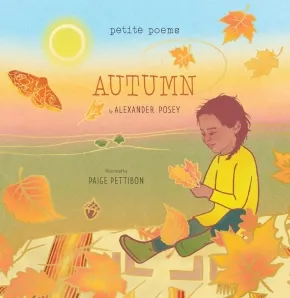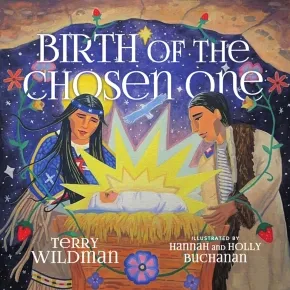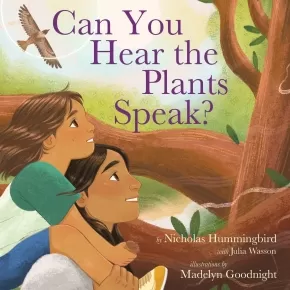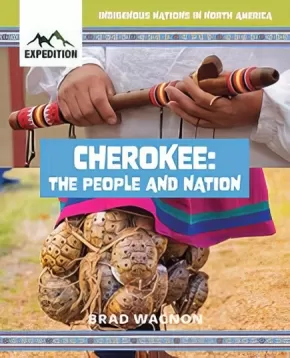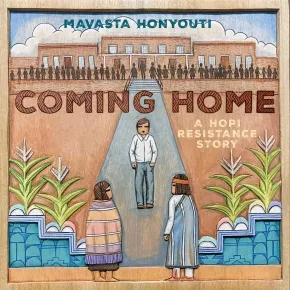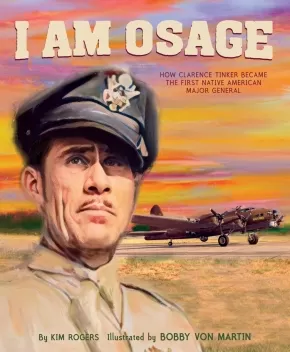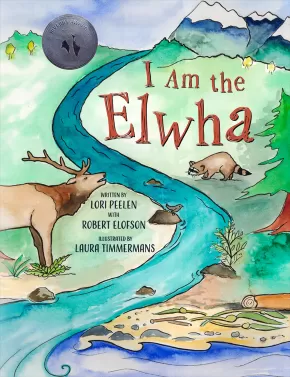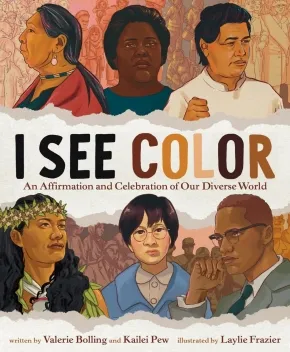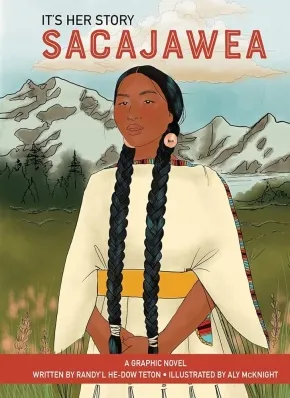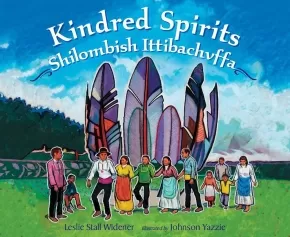
Indigenous Peoples in the United States
16
-
30
of
97 Results;
Sort By
Go To
of 7
The Seminoles
$12.49
Artists:
Format:
Paperback
Text Content Territories:
Indigenous American; Native American; Seminole;
ISBN / Barcode: 9780823460939
Synopsis:
Synopsis:
Award-winning author Virginia Driving Hawk Sneve introduces young readers to the Seminoles people.
The Seminoles are known as “the people who never surrendered.” As White settlers continued to encroach on their land, the Seminoles moved farther and farther into the Florida Everglades and adapted to their new environment with their hard work and ingenuity. And after defending their land in three Seminole wars, they never signed a formal peace treaty with the United States.
This accessible nonfiction picture book introduces the Seminoles’ early history, daily way of life, ceremonies, and more. Learn how they adapted to the Florida Everglades and their unique cultural practices, like their flat roll hairstyle and the role of an ever-burning fire in the annual Green Corn Dance. This updated edition provides the most up to date and accurate information on the Seminole people of past and present. The back of the book includes a section on Seminole life today.
Educator & Series Information
Recommended for ages 7 to 10.
This book is part of the First Americans series.
Additional Information
32 pages | 10.55" x 9.47" | Paperback
The Seneca: People, Culture, and History
$11.99
Format:
Paperback
Text Content Territories:
Indigenous American; Native American; Haudenosaunee (Iroquois); Seneca;
ISBN / Barcode: 9798875208614
Synopsis:
Synopsis:
Strong kinship, rich stories, and lasting traditions—that’s the Seneca Nation. In this engaging nonfiction book for young readers, discover more about the people, places, and practices that connect Seneca communities across the Haudenosaunee Confederacy. Learn how the Seneca people thrive today by safeguarding their language, maintaining customs, and honoring their heritage through ceremonies and council gatherings. Through interactive activities and engaging features—including maps, timelines, recipes, and stories—Seneca author Dr. Faye Lone offers young readers a window into the past, present, and future of this enduring culture.
Educator & Series Information
Recommended for ages 8 to 11.
This book is part of the Indigenous Peoples series.
Additional Information
32 pages | 7.00" x 9.00" | Paperback
The Sioux
$12.49
Artists:
Format:
Paperback
Text Content Territories:
Indigenous American; Native American; Sioux;
ISBN / Barcode: 9780823460953
Synopsis:
Synopsis:
Award-winning author Virginia Driving Hawk Sneve introduces young readers to the Sioux peoples.
The buffalo was the center of Sioux life. After hunting buffalo on horseback, the Sioux people would use every piece of the animal, making food, beds, clothing, storage boxes, and even sleds from the ribs! Discover how the Sioux people lived on the Great Plains with this accessible introduction. Learn about the Sioux creation story, life in the village as a kid, the importance of their feathered headdresses, and more.
This updated edition provides the most up to date and accurate information on the Sioux people of past and present. The back of the book includes a section on Sioux life today, proper names for all of the Sioux tribes, and an excerpt from the Lakota pipe ceremony.
Educator & Series Information
Recommended for ages 7 to 10.
This book is part of the First Americans series.
Additional Information
32 pages | 10.55" x 9.47" | Paperback
To Walk the Sky: How Iroquois Steelworkers Helped Build Towering Cities
$24.99
Artists:
Format:
Hardcover
ISBN / Barcode: 9780063046979
Synopsis:
Synopsis:
Look to the sky!
High above the ground, generation after generation, Native workers called skywalkers have sculpted city skylines, balancing on narrow beams, facing down terrifying heights and heartbreaking loss. These skywalkers who dared to touch the heavens have built a legacy of landmarks all over the North American continent—and even today, there are Native Americans still climbing up among the clouds, brave enough to walk the sky.
With impactful and illuminating prose, Patricia Morris Buckley (Mohawk) tells the soaring story of the remarkable skywalkers, whose bravery and tragedies are warmly captured in moving watercolors by award-winning artist E. B. Lewis (Lenni-Lenape).
Reviews
"By turns solemnly reverent and enthusiastic, Buckley’s elegant text will leave young people keenly aware of the historical and present-day significance of these groundbreaking workers, as well as their strength and resilience. Awe-inspiring." — Kirkus Reviews (starred review)
"Graceful language honors skywalkers throughout this stirring telling, while fluidly rendered watercolor illustrations in a desaturated color palette employ sweeping perspective and scale." — Publishers Weekly (starred review)
"This fascinating narrative provides an in-depth history of skywalkers, the Caughnawaga, and their contributions to our cities and infrastructure." — School Library Journal (starred review)
"The text, even with all its facts and figures, is deeply emotional, capturing the giddy danger of skywalking, the relentless need to better one’s life, and the sorrow in a preventable tragedy...blurring faces and bodies in a way that emphasizes the comradery and connection between the workers." — Bulletin of the Center for Children’s Books
"Here, a descendant of one of the 75 workers who died in the 1907 collapse of the Quebec Bridge pays eloquent tribute to the first generation of Mohawk “skywalkers” who came out of the Caughnawaga (later Kahnawà:ke) reserve in Canada." — Booklist
Educator Information
Recommended for ages 4 to 8.
Additional Information
40 pages | 8.50" x 11.00" | Hardcover
Who Was Wilma Mankiller?
$9.50
Format:
Paperback
Text Content Territories:
Indigenous American; Native American; Cherokee; Cherokee Nation (Cherokee Nation of Oklahoma);
ISBN / Barcode: 9780593888872
Synopsis:
Synopsis:
Learn about the life and legacy of the first woman to serve as principal chief of the Cherokee Nation! Wilma Mankiller's struggle for political change throughout her life will be sure to inspire readers in this addition to the #1 New York Times bestselling series.
Wilma Mankiller grew up immersed in the Cherokee community and culture of Oklahoma. When her family moved to San Francisco as part of the Indian Relocation Program, she had to quickly adjust to city life. Along the way, Wilma never lost her dedication to her people and their centuries-old traditions. She grew up to become a major political activist. From aiding the Occupation of Alcatraz in 1969 to making history as the first woman principal chief of the Cherokee Nation in 1985, Wilma never wavered in her support for her community. She spent her life fighting for the rights of Native Americans and inspires political activism to this day.
Educator Information
Recommended for ages 8 to 12.
Additional Information
112 pages | 5.31" x 7.62" | Paperback
Autumn
$19.99
Artists:
Format:
Hardcover
Text Content Territories:
Indigenous American; Native American; Muscogee (Creek);
Grade Levels: Preschool; Kindergarten;
ISBN / Barcode: 9781949480580
Synopsis:
Synopsis:
Discover the power of poetry in this simple, modern introduction to Indigenous poet Alexander Posey, featuring an ode to autumn and the changing seasons
Autumn depicts a dreamy fall day full of jaybird songs and scarlet leaves dancing through the air. In this poem, Muscogee poet Alexander Posey celebrates the changing of the seasons as the golden sun sets on summer and the world prepares for a time of rest. With stunning illustrations from Salish artist Paige Pettibon and interactive back matter that encourages young readers to create their own poetry, this accessible picture book is a joy for young poets and their parents alike.
Reviews
"A dreamy, succinct poem across many pages that all together encapsulates the sense of fall. A strong first purchase. The poem and artwork, which create an exquisite sense of a child’s joy in playing on an autumn afternoon, will appeal to all ages." — School Library Journal
Educator Information
Recommended for ages 3 to 5.
Additional Information
24 pages | 8.00" x 8.00" | Hardcover
Birth of the Chosen One: A First Nations Retelling of the Christmas Story
$24.99
Format:
Hardcover
Text Content Territories:
Indigenous American; Native American;
ISBN / Barcode: 9781514007020
Synopsis:
Synopsis:
A Fresh Retelling of the Christmas Story!
When they arrived, the time for Bitter Tears to have her child was upon her! But no place could be found in the lodging house, so He Gives Sons found a sheep cave where it was warm and dry.
There, Bitter Tears gave birth to her son. They wrapped him in a soft, warm blanket and laid him on a baby board. Then they placed him on a bed of straw in a feeding trough.
Every year at Christmas, Christians around the world celebrate the birth of Jesus—the Chosen One. Birth of the Chosen One is a unique retelling of this familiar story since it is an adaptation of the Gospel of Luke from the First Nations Version.
Birth of the Chosen One includes:
- The story of Jesus told in the tradition of Native storytellers' oral cultures
- A dynamic equivalence translation of the Christmas story that helps readers of all ages experience Scripture in a fresh and new way
- Illustrations from Native artists Hannah and Holly Buchanan
- A note from the author to encourage further conversation between children and the adults who read with them
Reviews
"It is a gentle, smooth account of Jesus' birth. I pray it reaches a vast audience encouraging each one's effort to search deeper." — Warren D. Petoskey, elder of the Waganakising Odawa and Minneconjou Lakotah nations and author of Dancing My Dream
Educator Information
Recommended for ages 4 to 8.
Additional Information
32 pages | 9.00" x 9.00" | Hardcover
Can You Hear the Plants Speak?
$24.99
Artists:
Format:
Hardcover
Text Content Territories:
Indigenous American; Native American; Apache; Cahuilla;
ISBN / Barcode: 9780063221284
Synopsis:
Synopsis:
Our people believe spirit lives in everything.
Mountain, river, wind, tree.
Come, take a walk with me.
What do we learn from plants when we listen to them speaking? Indigenous plantsman Nicholas Hummingbird calls on the legacy of his great-grandparents to remember how one drop of rain, one seed, one plant can renew a cycle of hope and connection—for him and for each of us.
Perfect for readers of Sy Montgomery, debut authors Nicholas Hummingbird and Julia Wasson joyfully proclaim even the youngest person can be an earth protector. With gorgeous illustrations from Rock Your Mocs artist Madelyn Goodnight, Can You Hear the Plants Speak? encourages us to engage with the natural world.
Educator Information
Recommended for ages 4 to 8.
Additional Information
40 pages | 10.00" x 10.00" | Hardcover
Cherokee: The People and Nation
$16.95
Format:
Paperback
Text Content Territories:
Indigenous American; Native American; Cherokee;
ISBN / Barcode: 9781774565117
Synopsis:
Synopsis:
In this book, discover the difficult journey of The Cherokee people. How they came to North America and how they were then removed with other Nations through The Trail of Tears. Learn about the seven Cherokee clans. Their culture, traditions, and language as it was the first Indigenous language put into writing.
Educator & Series Information
This book is part of the Indigenous Nations in North America series.
Additional Information
32 Pages | Paperback
Coming Home: A Hopi Resistance Story
$28.99
Artists:
Format:
Hardcover
ISBN / Barcode: 9781646144570
Synopsis:
Synopsis:
From master Hopi woodcarver Mavasta Honyouti, the story of his grandfather’s experience at a residential boarding school and how he returned home to pass their traditions down to future generations.
When Mavasta Honyouti was a boy he would go with his grandfather to their cornfield, watching him nurture every plant. During breaks, his grandfather would take out a piece of paako root and use his pocketknife to whittle away. He made beautiful carvings that Mavasta would later learn to do himself.
But Mavasta would often wonder: what was his kwa’a like when he was a boy? And one day, he heard the story.
Mavasta’s grandfather, like many Native American children across the country in the late 19th and early 20th century, was forced to leave his Hopi reservation as a child and go to a residential boarding school far away. There, the government cut his hair, punished him for speaking his native language, and gave him a new name. But Mavasta's grandfather never forgot who he was – or where he came from – and he tried to escape again and again. Finally, he made it back to their reservation.
In later years, Mavasta’s kwa’a chose a simple life, taking great care of his family just like he took great care of his plants. His son and later his grandson became acclaimed Hopi katsina woodcarvers, just like him. Coming Home: A Hopi Resistance Story is a deeply personal book – written in both English and Hopi – that features sixteen stunning original painted wood carvings. It is an unforgettable testament to one man rising above a painful piece of history to keep the light of his family and culture alive.
Educator Information
Recommended for ages 4 to 8.
Dual-language: English and Hopi.
Additional Information
48 pages | 9.00" x 9.20" | Hardcover
I Am Osage: How Clarence Tinker Became the First Native American Major General
$24.99
Artists:
Format:
Hardcover
Text Content Territories:
Indigenous American; Native American; Osage;
ISBN / Barcode: 9780063081161
Synopsis:
Synopsis:
This informative and inspiring picture book by acclaimed author Kim Rogers (Wichita), with striking artwork by debut illustrator Bobby Von Martin (Choctaw), celebrates the achievements of Clarence Tinker, a member of the Osage Nation who became the first Native American major general.
Clarence Tinker always knew that he wanted to do something extraordinary. Something adventurous. Something that made a difference in the world.
But as a member of the Osage Nation at the turn of the twentieth century, there were a lot of obstacles that he had to face to achieve his dreams. When he was a child, Clarence was taken away from his family and community. He was forced to attend a prisonlike boarding school, like many other Native children of his generation. There, he wasn’t able to speak his language or practice his Osage customs.
Still, Clarence kept his dream close to his heart and joined the US Army with the goal of becoming an officer. Though he was treading an unfamiliar path, he worked hard and never forgot his Osage values and traditions that, ultimately, paved his way to success.
I Am Osage, the first nonfiction project from the Heartdrum imprint, combines gorgeous, vibrant artwork with a stirring text that celebrates an unsung hero while also shedding light on significant American history.
Features an author’s note and timeline.
Educator Information
Recommended for ages 4 to 8.
Additional Information
40 pages | 9.00" x 11.00" | Hardcover
I Am the Elwha (PB)
 $14.95
$14.95

Artists:
Format:
Paperback
Text Content Territories:
Indigenous American; Native American; Salish; Coast Salish; Klallam (Clallam); Lower Elwha Klallam Tribe;
ISBN / Barcode: 9781771746311
Synopsis:
Synopsis:
"I am the Elwha, rushing down to the sea. I am the Elwha, wild and free."
The Elwha River flows 72km (45 miles) from its source in the Olympic Mountains to the Strait of Juan de Fuca in the Pacific Northwest. Uniquely, it hosts all six salmon species (Pink, Chinook, Coho, Sockeye, Steelhead, and Chum) as well as several species of trout.
In 1911, two dams were built on the river. The dams blocked the migration routes of the salmon and dramatically altered the entire river ecosystem for 100 years. In 2012, the dams were decommissioned and the world's largest dam removal and habitat restoration project began. In this lyrical and beautifully illustrated book, the author chronicles the history of the Elwha.
Narrated by the powerful voices of plants and animals that inhabit the river ecosystem, the dam builder, a worker, members of the Klallam Tribe, and the river itself, this story celebrates the ongoing rewilding of this special environment and offers a welcome to all the creatures who are coming home.
To learn more visit: www.elwha.org
Awards
- 2021 Riverby Award for Young Readers
Reviews
“I Am the Elwha is a powerful read about a powerful river and those who value and protect it." – Raina Delisle, Hakai Magazine
Educator Information
Recommended for grades 3 to 7.
At the back of the book are three pages of cultural, scientific, and historical information that discuss the following:
- the importance and symbolism of salmon to the Lower Elwha Klallam Tribe and other Coastal Salish Tribes
- facts about the six species of salmon found in the Elwha River (Chinook, Pink, Chum, Sockeye, Coho, and Steelhead)
- the history of the Elwha River and its status today
Keywords / Subjects: The Elwha River, Rivers, Dams, History, Environmental Awareness, Lower Elwha Klallam Tribe, Coast Salish, Native American, Culture, Washington, Animals, Salmon, First Salmon Ceremony, Plants, Nature, Settlers, Social Responsibility, Environmental Activism, Poetry.
Additional Information
32 Pages | 8.5" x 11" | ISBN: 9781771746311 | Second Edition | Paperback
Authenticity Note: This lyrical story, which chronicles the history of the Elwha River, is written by Lori Peelen. Robert Elofson, Tribal Elder and Harvest Manager in the Natural Resources Department for the Lower Elwha Klallam Tribes, approved Lori's work and contributed pages of back matter at the end of the work. Lori's story was further approved by Frances Charles, the Tribal Councilwoman for the Lower Elwha Klallam Tribe, after the entire council read and approved it.
The Canadian Content label has been applied because the illustrator of this work is Canadian.
I See Color
$24.99
Artists:
Format:
Hardcover
Text Content Territories:
Indigenous American | Native American|
ISBN / Barcode: 9780063234260
Synopsis:
Synopsis:
For fans of The Undefeated by Kwame Alexander and Little Leaders by Vashti Harrison, I See Color is a picture book that affirms people of color—of all shades—by celebrating their achievements and contributions to society.
Highlighting people such as Madonna Thunder Hawk, Basemah Atweh, and Dr. Martin Luther King Jr., incredible leaders are honored, seen, and heard on every page.
Part ode to an array of beautiful skin tones and part introduction to change-makers in history, this book is a perfect conversation starter for readers everywhere.
Reviews
"The love and appreciation of color shines through this vibrant retrospective on activism, courage, and resistance." — Kirkus Reviews (starred review)
"An eye-opening album to be read, cherished, used as a cornerstone for study, or shared across curricula." — School Library Journal (starred review)
"[T]his high-level work underscores “all that can be achieved together.” — Publishers Weekly
Educator Information
Recommended for ages 4 to 8.
Includes some Indigenous content.
Additional Information
40 pages | 9.00" x 11.00" | Hardcover
It's Her Story Sacajawea: A Graphic Novel (7 in Stock)
$37.50
Artists:
ISBN / Barcode: 9798765402962
Synopsis:
Synopsis:
A graphic novel for children ages 7 to 10. Sacajawea was a brilliant, multilingual Shoshone girl who was torn from her home at a young age. In 1804, she set out with the Lewis and Clark Expedition, acting as an interpreter and guide across hundreds of miles of unmapped land to reach the Pacific Ocean. Almost 200 years later, she became the first Indigenous woman to appear on a US coin. This is her story.
Educator Information
Recommended for ages 7 to 10.
Additional Information
42 Pages | 6.5o" x 8.10 | Library Binding
Kindred Spirits: Shilombish Ittibachvffa
$21.99
Artists:
Format:
Hardcover
Text Content Territories:
Indigenous American; Native American; Choctaw; Hopi; Navajo (Diné);
ISBN / Barcode: 9781623543969
Synopsis:
Synopsis:
Those who feel the same are kindred spirits.
A nonfiction picture book about the inspiring true pay-it-forward story that bridges two continents, 175 years, and two events in history--connecting Ireland, Choctaw Nation, Navajo Nation, and the Hopi Tribe.
1845. The Potato Famine devastated Ireland. An ocean away, Choctaw people heard and were moved by the similarities to the injustice they had suffered on the Trail of Tears. Though they had little, they gathered money to donate.
2017. Irish people built a statue to remember their connection to the Choctaw Nation--twenty-foot high feathers in the shape of a bowl.
2020. COVID-19 disproportionately ravished the Navajo Nation and the Hopi Tribe. Irish people remembered the Choctaws' kindness and paid it forward by donating.
Empathy creates kindness that lives well beyond a single act and includes more people the bigger it grows.
Educator Information
Recommended for ages 5 to 8.
Additional Information
32 pages | 11.00" x 9.00" | Hardcover
Sort By
Go To
of 7

